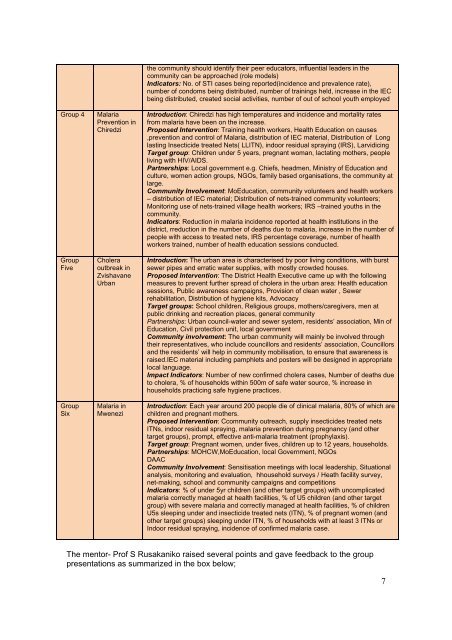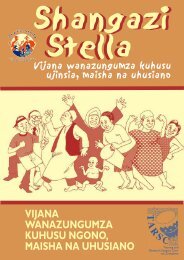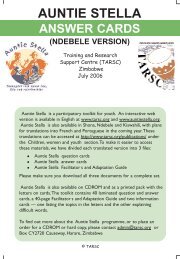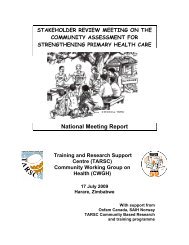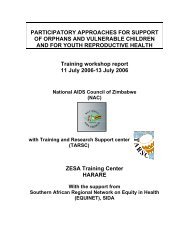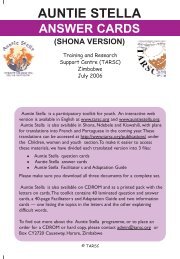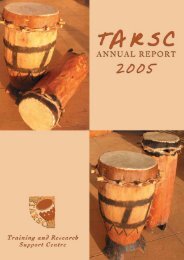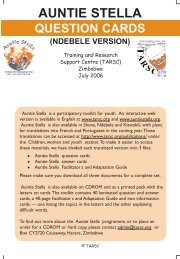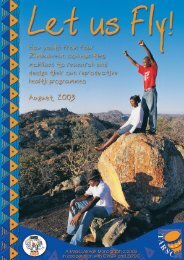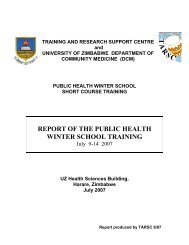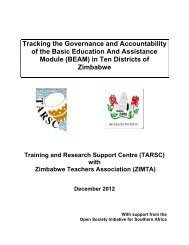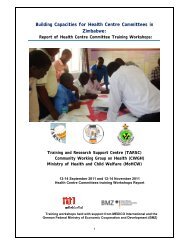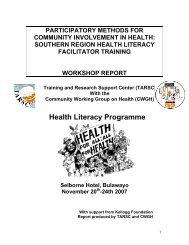WS10 Report.pdf - Training and Research Support Centre
WS10 Report.pdf - Training and Research Support Centre
WS10 Report.pdf - Training and Research Support Centre
You also want an ePaper? Increase the reach of your titles
YUMPU automatically turns print PDFs into web optimized ePapers that Google loves.
Group 4<br />
Group<br />
Five<br />
Group<br />
Six<br />
Malaria<br />
Prevention in<br />
Chiredzi<br />
Cholera<br />
outbreak in<br />
Zvishavane<br />
Urban<br />
Malaria in<br />
Mwenezi<br />
the community should identify their peer educators, influential leaders in the<br />
community can be approached (role models)<br />
Indicators: No. of STI cases being reported(incidence <strong>and</strong> prevalence rate),<br />
number of condoms being distributed, number of trainings held, increase in the IEC<br />
being distributed, created social activities, number of out of school youth employed<br />
Introduction: Chiredzi has high temperatures <strong>and</strong> incidence <strong>and</strong> mortality rates<br />
from malaria have been on the increase.<br />
Proposed Intervention: <strong>Training</strong> health workers, Health Education on causes<br />
,prevention <strong>and</strong> control of Malaria, distribution of IEC material, Distribution of Long<br />
lasting Insecticide treated Nets( LLITN), indoor residual spraying (IRS), Larvidicing<br />
Target group: Children under 5 years, pregnant woman, lactating mothers, people<br />
living with HIV/AIDS.<br />
Partnerships: Local government e.g. Chiefs, headmen, Ministry of Education <strong>and</strong><br />
culture, women action groups, NGOs, family based organisations, the community at<br />
large.<br />
Community Involvement: MoEducation, community volunteers <strong>and</strong> health workers<br />
– distribution of IEC material; Distribution of nets-trained community volunteers;<br />
Monitoring use of nets-trained village health workers; IRS –trained youths in the<br />
community.<br />
Indicators: Reduction in malaria incidence reported at health institutions in the<br />
district, rreduction in the number of deaths due to malaria, increase in the number of<br />
people with access to treated nets, IRS percentage coverage, number of health<br />
workers trained, number of health education sessions conducted.<br />
Introduction: The urban area is characterised by poor living conditions, with burst<br />
sewer pipes <strong>and</strong> erratic water supplies, with mostly crowded houses.<br />
Proposed Intervention: The District Health Executive came up with the following<br />
measures to prevent further spread of cholera in the urban area: Health education<br />
sessions, Public awareness campaigns, Provision of clean water , Sewer<br />
rehabilitation, Distribution of hygiene kits, Advocacy<br />
Target groups: School children, Religious groups, mothers/caregivers, men at<br />
public drinking <strong>and</strong> recreation places, general community<br />
Partnerships: Urban council-water <strong>and</strong> sewer system, residents’ association, Min of<br />
Education, Civil protection unit, local government<br />
Community involvement: The urban community will mainly be involved through<br />
their representatives, who include councillors <strong>and</strong> residents’ association, Councillors<br />
<strong>and</strong> the residents’ will help in community mobilisation, to ensure that awareness is<br />
raised.IEC material including pamphlets <strong>and</strong> posters will be designed in appropriate<br />
local language.<br />
Impact Indicators: Number of new confirmed cholera cases, Number of deaths due<br />
to cholera, % of households within 500m of safe water source, % increase in<br />
households practicing safe hygiene practices.<br />
Introduction: Each year around 200 people die of clinical malaria, 80% of which are<br />
children <strong>and</strong> pregnant mothers.<br />
Proposed Intervention: Ccommunity outreach, supply insecticides treated nets<br />
ITNs, indoor residual spraying, malaria prevention during pregnancy (<strong>and</strong> other<br />
target groups), prompt, effective anti-malaria treatment (prophylaxis).<br />
Target group: Pregnant women, under fives, children up to 12 years, households.<br />
Partnerships: MOHCW,MoEducation, local Government, NGOs<br />
DAAC<br />
Community Involvement: Sensitisation meetings with local leadership, Situational<br />
analysis, monitoring <strong>and</strong> evaluation, hhousehold surveys / Heath facility survey,<br />
net-making, school <strong>and</strong> community campaigns <strong>and</strong> competitions<br />
Indicators: % of under 5yr children (<strong>and</strong> other target groups) with uncomplicated<br />
malaria correctly managed at health facilities, % of U5 children (<strong>and</strong> other target<br />
group) with severe malaria <strong>and</strong> correctly managed at health facilities, % of children<br />
U5s sleeping under <strong>and</strong> insecticide treated nets (ITN), % of pregnant women (<strong>and</strong><br />
other target groups) sleeping under ITN, % of households with at least 3 ITNs or<br />
Indoor residual spraying, incidence of confirmed malaria case.<br />
The mentor- Prof S Rusakaniko raised several points <strong>and</strong> gave feedback to the group<br />
presentations as summarized in the box below;<br />
7


